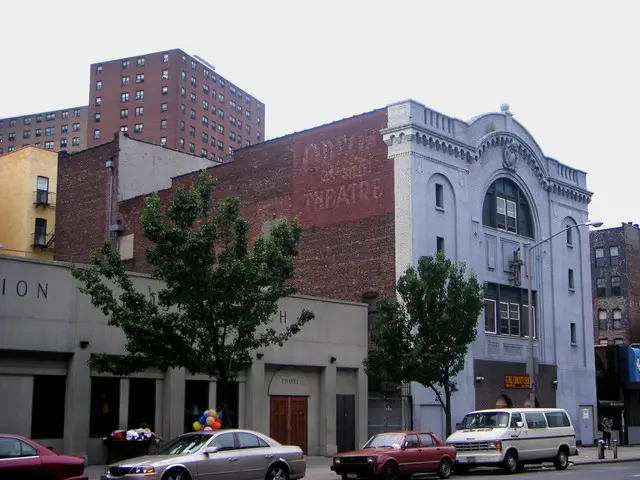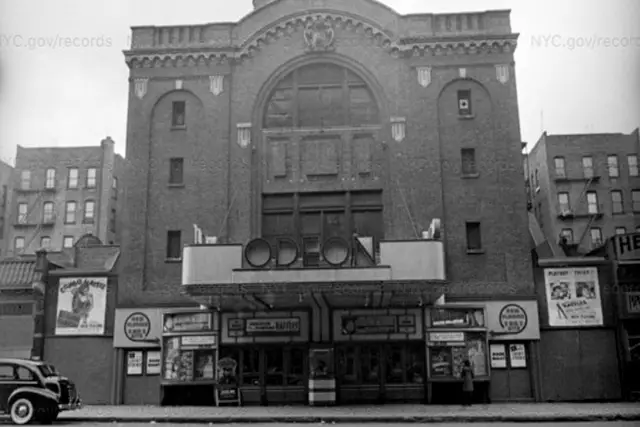The Harlem Renaissance was a period of flourishing arts, with New York City’s Harlem neighborhood offering African-American artists a place to freely express themselves artistically, intellectually, and politically.
Iconic figures, including Langston Hughes, Zora Neale Hurston, Louis Armstrong, Duke Ellington, and Billie Holiday all contributed to this artistic and cultural movement.

The Great Migration of Black Americans from the Jim Crow South to Northern cities facilitated the growth of the Harlem community. Census data shows Harlem’s black population steadily rising from about 10% Black in 1910, to 70% in 1930.
Harlem is home to perhaps one of the most iconic theaters in the world, The Apollo Theater. During the 20’s and 30’s, Harlem’s stages, including the Apollo Theater, were home to iconic musical and artistic talents. One theater some 20 blocks north, the Odeon Theatre on 145th Street, screened movies for black audiences and highlighted black cinema.

In the early 20th century, developments in film were changing the nature of cinema. Silent films, known as nickelodeons, offered an accessible pastime for a wider audience. Nickelodeons were typically shown in small, cramped, and dingy venues, and as the name implies, admission cost 5¢. Cinema became a pastime of the working class, and was dismissed as low brow.
As films became more sophisticated, with full-length feature films becoming the new norm, nickelodeons went out of style, along with the small theaters they were shown in. Demand for beautiful, comfortable, family-friendly palaces of cinema grew, and prolific architect Thomas W. Lamb answered the call.
A visionary of his time, Thomas W. Lamb revolutionized the entertainment industry. There are hundreds of theaters credited to him, with at least 48 in New York. As films entered mainstream popular culture, grand, opulent movie theaters such as the Odeon became popular.

The Odeon Theatre was opened in early-1911 by the M. Morgenthau Jr. Co. and was first used as a vaudeville theatre with motion picture use. The 1,100-seat Odeon Theatre was an early theatre designed by noted architect Thomas W. Lamb. It was leased to the 16th Street Theatre Company in August 1911. The theater was an immediate success, showing vaudeville performances and silent films.
By 1925, Frank Schiffman and Leo Brecher, who later owned the Apollo, converted the theater to only show films. For many years it was operated by the same chain that operated the nearby Roosevelt Theatre on 7th Avenue and the Douglas Theatre on Lenox Avenue.

The 1933 ad above from newspaper The New York Age highlights the Odeon’s comfortable and cool atmosphere, which would appeal to city dwellers living pre-air conditioning. The New York Age was a prominent Black newspaper established in 1887, focusing on stories relevant to black audiences and communities.

An advertisement for a showing of the 1948 Italian film, Without Pity, is above. The movie’s first showings in Harlem were at the Odeon, and the nearby Renaissance Ballroom.
Without Pity is a thriller starring a Black American soldier, who falls in love with an Italian woman. The Odeon, along with other Harlem theaters, showed movies starring and centered around Black characters.
Harlem allowed Black creatives, including journalists, poets, musicians, and visual artists, to make work relevant to them. Films with black characters and newspapers focusing on black communities flourished, and so did the Odeon.

Post War Odeon Theatre & St. Paul’s Church
The movie palace period came to an end after World War II, when function became the primary concern in architecture. The Odeon has continued to evolve with the needs of the community, and is emblematic of change in New York.
While is important to recognize what once was, the evolution of the Odeon and Harlem as a community are representative of New York as a whole: constantly shifting to the needs of the people, while keeping the past in our hearts and minds.
The Great Depression gravely hurt the entertainment business in the 1930s, and the Harlem Renaissance came to an end. The legacy of the movement, however, continues to this day. Socially and politically conscious art was at the center of the Harlem Renaissance, and inspired future generations of black artists and thinkers.
Odeon 145th Street Theatre is now St. Paul Community Church. The original painted sign is still visible on the upper side walls, stating ‘Odeon Theatre, 145th Street’.


Comments are closed.